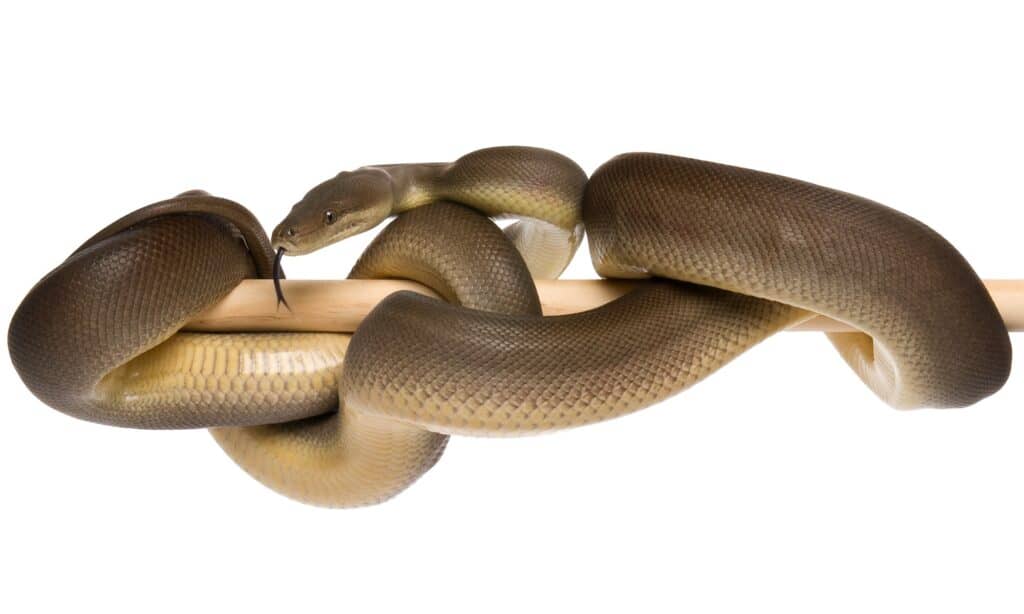Olive python
Liasis olivaceus
The olive python is a gentle giant that is rarely aggressive.
Advertisement
Olive python Scientific Classification
- Kingdom
- Animalia
- Phylum
- Chordata
- Class
- Reptilia
- Order
- Squamata
- Family
- Pythonidae
- Genus
- Liasis
- Scientific Name
- Liasis olivaceus
Read our Complete Guide to Classification of Animals.
Olive python Conservation Status
Olive python Facts
- Prey
- Mammals, but also takes birds and other snakes.
- Name Of Young
- Hatchling, snakelet
- Group Behavior
- Solitary except during mating season
- Fun Fact
- The olive python is a gentle giant that is rarely aggressive.
- Biggest Threat
- Feral foxes and cats depleting their prey.
- Most Distinctive Feature
- Iridescent olive to brown solid color.
- Diet for this Fish
- Omnivore
- Lifestyle
- Nocturnal
- Crepuscular
Olive python Physical Characteristics
- Color
- Brown
- Fawn
- Olive
- Light-Brown
- Skin Type
- Scales
- Lifespan
- 40+ years
- Length
- Over 13 feet
- Age of Sexual Maturity
- 2-5 years
- Venomous
- No
- Aggression
- Low
View all of the Olive python images!
The olive python is Australia’s third longest snake; only the Oenpelli python and amethystine python are longer.
This very long but relatively docile snake is sometimes killed because people confuse it with the venomous king brown snake (Pseudechis australis). It is long and strong, and the adults often reach 13 feet long. The Pilbara olive python sometimes reaches 20.
Incredible Olive Python Facts
- It appears smoother than other pythons because it has an unusually large number of dorsal scale rows.
- On a continent full of big and dangerous animals, the olive python is either the second or the third longest python in Australia.
- It is part of the Rainbow Serpent of Aboriginal legend.
Olive Python Scientific Name and Classification
The olive python is a long, somewhat thin snake in the family Pythonidae. It’s part of the Liasis genus with its close cousin, the Savu python. The genus name may be related to Lias, a blue limestone. This snake is native to Australia, and its specific name, olivaceus, means olive-colored. The common name reflects their color too.
Types of Olive Python
There are two subspecies, the Pilbara olive python (Liasis o. barroni), and the nominate subspecies, the olive python (Liasis o. olivaceus).
The Pilbara olive python population is isolated to Pilbara, a small region in Western Australia. At least one has made the news when it was sunning itself on the rocks where a family was hiking.
The olive python has a much wider range than the Pilbara subspecies and inhabits Australia along the northern reaches of Western Australia, the Northern Territory, and Queensland.
Olive Python Appearance
The olive python often exceeds 13 feet long, including the tail; those in the Pilbara region can reach 19 feet long, but this is a rarity. According to some sources, this is the third longest snake species in Australia. However, others say that it’s the second longest. In any case, only the Oenpelli and amethystine pythons can get longer, but it may be a tie with the Oenpelli python for length.
Their bodies range in color from chocolate brown to olive green with a cream-colored belly and lips. These snakes are unusual in that they have no pattern, just a solid, even color that shimmers iridescently in the sunlight. This species looks smoother in comparison to other pythons because it has more rows of dorsal scales than other pythons.
Like other pythons, the olive python has a large number of razor-sharp teeth that are pointed toward the back of its mouth. Its heat-sensing pits are located along the upper labial (lip) scales in the front and on the lower lips in the back. Their eyes are somewhat large and have vertical pupils, which help them see better at night because olive pythons are nocturnal and crepuscular – daytime isn’t their thing. As is typical of pythons, they have a triangular head and blunt nose.

Olive pythons can be snappy as hatchlings, but quickly mellow out and become gentle snakes.
©iStock.com/andrewburgess
Olive Python Behavior
These are nocturnal snakes, but they’re also active during the day when the weather is cooler in spring and fall. The olive python spends the cooler months hiding in caves and crevices, away from water sources. But when the temperatures rise, so do they. Both subspecies are very active and move around frequently, often near water sources. They are excellent swimmers and do not hesitate to cross a body of water looking for prey.
Both subspecies are ambush predators and often hide in caves and crevices, waiting to strike from a hiding spot. They’re also known to hide near game trails, waiting for their meal. Olive pythons are especially adept at using water holes and strike at prey from under the water.
In captivity, they can be very gentle snakes when obtained as a hatchling and worked with regularly. They are more difficult to keep, not because they’re overly sensitive, but because of their activity level, food, and exercise needs. Olive pythons require a very large enclosure to be happy and healthy.
Olive Python Habitat and Diet
Their native habitat is varied; some parts of their range are tropical, and others are more temperate. Regardless of where they occur, olive pythons prefer to have rock outcrops and water sources and frequently use caves for shelter. This species inhabits gorges and areas with rock outcrops, trees, water, and caves. Usually, these snakes find shelter in caves and rock crevices, but they’ll also take a hollow log or an abandoned burrow.
Olive pythons are semi-arboreal and are quick to climb trees after prey. It’s a pretty big snake to be so active, yet these snakes spend a fair amount of time exploring rock outcrops and crevices, looking for a meal. They are opportunistic and will eat anything they can overpower and swallow; this includes other reptiles such as snakes. Yet, they mainly eat rock wallabies, fruit bats, ducks, spinifex pigeons, and coucals.
Olive Python Predators, Threats, Conservation, and Population
As of 2017, the IUCN assessment showed that the species had no major threats. It’s on the IUCN Redlist of Threatened Species as “Least Concern.” In general, it’s wide-ranging and reproduces easily in the wild.
The Pilbara olive python population is listed as Vulnerable in Australia. It occurs in the Pilbara region in pockets, and these pockets seem to be pretty well populated. However, they’re pockets versus being wide-ranging like the other subspecies. So, it puts them at a higher risk.
According to the Perth Zoo, all olive pythons face the main threats of predation by feral foxes and cats, which deplete natural food sources, and a loss of habitat. They’re also roadkill victims and are killed by people when they mistake this nonvenomous snake for the highly venomous king brown snake.
Like other young snakes, when these snakes are young, they have many natural predators. Anything from crocodiles to birds of prey and carnivorous mammals can eat the little snakes. As they grow, they become apex predators with few other animals that can challenge them.
Olive Python Reproduction, Babies, and Lifespan
Olive pythons reach sexual maturity between 2 and 5 years old. The mating season for olive pythons runs from May to mid-July each year. Several weeks after a successful mating, females lay clutches of 12-40 eggs that they coil around and protect until hatching, which happens about 80 days later. This is longer than most pythons, which hatch after about 60 days.
After hatching, the babies stay there for a few days to absorb the rest of the yolk from their eggs. After that, they are on their own. These pythons live a very long time, and some in captivity are over 40 years old.
Next Up
- Meet the Savu python, a big python in a small package.
- Oenpelli pythons are also restricted to a small region of Australia. They’re long, thin, and love the trees.
- Australians call the amethystine python a scrub python or scrubbie. This is the longest python in Australia and is often the cause of mayhem in human homes during mating season.
Olive python FAQs (Frequently Asked Questions)
Where do olive pythons live?
Only in northern Australia. They’re either the second or the third longest python in Australia, depending on who you ask.
How do olive pythons hunt?
They ambush their prey. They like to sit off to the side of game trails and grab a quick meal. These snakes also hide in the water and strike from there.
Do olive pythons make good pets?
Yes. IF you have the space for them. They are very active snakes and need a very large enclosure – at least eight feet long and four feet tall.
What do olive pythons eat?
They prefer mammals and birds, but also take lizards and other snakes.
Thank you for reading! Have some feedback for us? Contact the AZ Animals editorial team.
Sources
- Doughty, P., Ellis, R., Melville, J., Teale, R. & Wilson, S. 2017. Liasis olivaceus. The IUCN Red List of Threatened Species 2017: e.T83776720A101753099. https://dx.doi.org/10.2305/IUCN.UK.2017-3.RLTS.T83776720A101753099.en. Accessed on 29 July 2022., Available here: https://www.iucnredlist.org/species/83776720/101753099
- Liasis olivaceus | Reptarium Reptile Database, Available here: https://reptile-database.reptarium.cz/species?genus=Liasis&species=olivaceus
- Olive Python | Perth Zoo, Available here: https://perthzoo.wa.gov.au/animal/olive-python
- A Revision of the Australasian Pythons, Hoser, Raymond | Ophidia Review, Available here: http://www.smuggled.com/pytrsm1.pdf

















